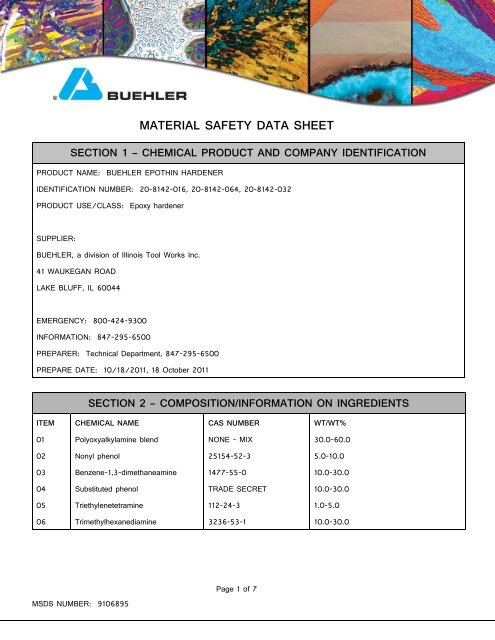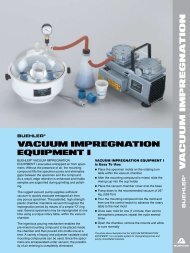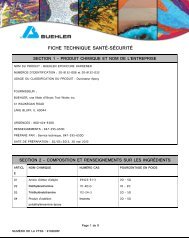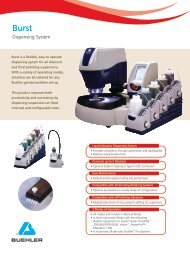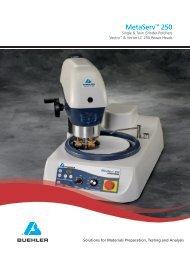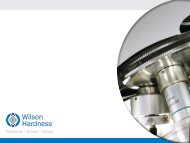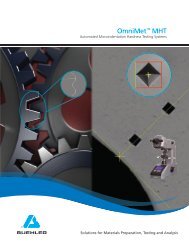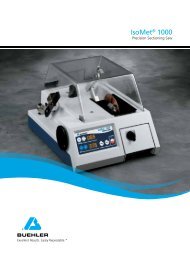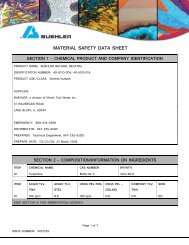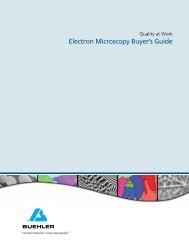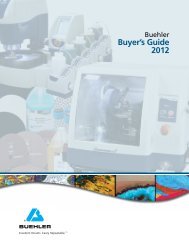material safety data sheet - Buehler
material safety data sheet - Buehler
material safety data sheet - Buehler
Create successful ePaper yourself
Turn your PDF publications into a flip-book with our unique Google optimized e-Paper software.
MSDS NUMBER: 9106895<br />
MATERIAL SAFETY DATA SHEET<br />
SECTION 1 – CHEMICAL PRODUCT AND COMPANY IDENTIFICATION<br />
PRODUCT NAME: BUEHLER EPOTHIN HARDENER<br />
IDENTIFICATION NUMBER: 20-8142-016, 20-8142-064, 20-8142-032<br />
PRODUCT USE/CLASS: Epoxy hardener<br />
SUPPLIER:<br />
BUEHLER, a division of Illinois Tool Works Inc.<br />
41 WAUKEGAN ROAD<br />
LAKE BLUFF, IL 60044<br />
EMERGENCY: 800-424-9300<br />
INFORMATION: 847-295-6500<br />
PREPARER: Technical Department, 847-295-6500<br />
PREPARE DATE: 10/18/2011, 18 October 2011<br />
SECTION 2 – COMPOSITION/INFORMATION ON INGREDIENTS<br />
ITEM CHEMICAL NAME CAS NUMBER WT/WT%<br />
01 Polyoxyalkylamine blend NONE - MIX 30.0-60.0<br />
02 Nonyl phenol 25154-52-3 5.0-10.0<br />
03 Benzene-1,3-dimethaneamine 1477-55-0 10.0-30.0<br />
04 Substituted phenol TRADE SECRET 10.0-30.0<br />
05 Triethylenetetramine 112-24-3 1.0-5.0<br />
06 Trimethylhexanediamine 3236-53-1 10.0-30.0<br />
Page 1 of 7
ITEM ACGIH TLV-<br />
TWA<br />
MSDS NUMBER: 9106895<br />
SECTION 2 – COMPOSITION/INFORMATION ON INGREDIENTS<br />
ACGIH TLV-<br />
STEL<br />
OSHA PEL-TWA OSHA PEL –<br />
Page 2 of 7<br />
CEILING<br />
COMPANY TLV-<br />
N.E N.E N.E N.E N.E N.E NO<br />
02 N.E N.E N.E N.E N.E NO<br />
03 N.E 0.1 mg/m 3 N.E N.E 0.1mg/m 3 (C) NO<br />
04 N.E N.E N.E N.E N.E NO<br />
05 N.E N.E N.E N.E N.E NO<br />
06 N.E N.E N.E N.E N.E NO<br />
(SEE SECTION 16 FOR ABBREVIATION LEGEND)<br />
SECTION 3 – HAZARDS IDENTIFICATION<br />
EMERGENCY OVERVIEW: Harmful if swallowed or absorbed through skin. Causes eye burns. Causes skin burns.<br />
Vapors irritating to eyes and respiratory tract. May cause allergic skin reaction. Harmful to aquatic organisms.<br />
ACUTE EFFECTS – EYE CONTACT: CORROSIVE to the eyes and may cause severe damage including blindness.<br />
ACUTE EFFECTS - SKIN CONTACT: May be absorbed through the skin in harmful amounts. Strong skin sensitizer.<br />
CORROSIVE. Contact may cause chemical burns and blistering.<br />
ACUTE EFFECTS – INHALATION: Harmful if inhaled. Liquid aspirated into lungs may cause serious injury or death.<br />
Vapors and/or aerosols formed at elevated temperatures can be irritating. Prolonged or very high overexposure may<br />
cause burns to the mucous membranes with severe pneumonitis.<br />
ACUTE EFFECTS - INGESTION: Can burn mouth, throat and stomach, with nausea, severe pain, and vomiting. Slightly<br />
toxic.<br />
CHRONIC OVEREXPOSURE EFFECTS: *Triethylenetetramine (TETA) caused embryofetal toxicity and fetal<br />
malformations when fed to pregnant rats. Similar effects were not seen in studies in which this <strong>material</strong> was applied to the<br />
skin of rabbits, a more relevant route of industrial exposure. These effects are believed to be secondary to copper<br />
deficiency, resulting from the chelating activity of the amine. *Preexisting pulmonary and dermatological disorders may be<br />
aggravated by exposure to hazardous components. *Pregnant rats fed high doses of <strong>material</strong> during pregnancy showed<br />
evidence of fetal injury.<br />
OTHER INFORMATION: No information.<br />
PRIMARY ROUTE(S) OF ENTRY: SKIN CONTACT, SKIN ABSORPTION, INHALATION, EYE CONTACT<br />
TWA<br />
SKIN
MSDS NUMBER: 9106895<br />
SECTION 4 – FIRST AID MEASURES<br />
EYE CONTACT: Immediately flush eyes with plenty of water for at least 15 minutes. Get immediate medical attention.<br />
SKIN CONTACT: Immediately flush skin with plenty of water. Remove clothing. Get medical attention immediately.<br />
Wash clothing separately before reuse.<br />
INHALATION: Remove to fresh air. If not breathing, give artificial respiration. If breathing is difficult, give oxygen. Get<br />
medical attention.<br />
INGESTION: If swallowed, do NOT induce vomiting. Give victim a glass of water or milk. Call a physician or poison<br />
control center immediately. Never give anything by mouth to an unconscious person.<br />
NOTES TO PHYSICIAN: Treat symptomatically. If swallowed, gastric lavage is indicated.<br />
FLASH POINT: 230 F (PENSKY-MARTENS C.C.)<br />
LOWER EXPLOSIVE LIMIT: N.A.<br />
UPPER EXPLOSIVE LIMIT: N.A.<br />
AUTOIGNITION TEMPERATURE: No <strong>data</strong><br />
SECTION 5 – FIRE FIGHTING MEASURES<br />
EXTINGUISHING MEDIA: FOAM, CO 2, DRY CHEMICAL, WATER FOG, ALCOHOL FOAM<br />
UNUSUAL FIRE AND EXPLOSION HAZARDS: Closed containers may rupture or explode (due to pressure build-up)<br />
when exposed to extreme heat. Irritating and/or toxic gases or fumes may be generated by thermal decomposition or<br />
combustion.<br />
SPECIAL FIREFIGHTING PROCEDURES: Use NIOSH-approved self-contained breathing apparatus and full protective<br />
clothing. Use water to cool exposed containers. Water stream directed into fire may cause frothing with subsequent<br />
spread of flame.<br />
SECTION 6 – ACCIDENTAL RELEASE MEASURES<br />
STEPS TO BE TAKEN IN CASE MATERIAL IS RELEASED OR SPILLED: Reclaim clean <strong>material</strong>. Wear appropriate<br />
protective equipment during cleanup. Absorb with inert <strong>material</strong>, such as clay. Sweep or shovel into loosely-covered<br />
waste container and remove to appropriate waste area. Dispose of in accordance with federal, state, and local<br />
regulations. Harmful to aquatic organisms. Prevent entry into drains and/or waterways.<br />
Page 3 of 7
MSDS NUMBER: 9106895<br />
SECTION 7 – HANDLING AND STORAGE<br />
HANDLING: Remove contaminated clothing and wash before reuse. Use only in a well ventilated area. Avoid breathing<br />
dust, vapor, mist or gas. Avoid contact with skin and eyes. FOR INDUSTRIAL USE ONLY. Empty containers may<br />
retain product residue and can be dangerous. Observe all labeled precautions even after container is emptied.<br />
STORAGE: Keep container closed when not in use.<br />
SECTION 8 – EXPOSURE CONTROLS/PERSONAL PROTECTION<br />
ENGINEERING CONTROLS: Local exhaust as needed to control vapor or dust levels to below lowest component TLV.<br />
RESPIRATORY PROTECTION: None normally required under general ventilation. If TLV/PEL is exceeded, if use is<br />
performed in a poorly-ventilated space, or if inhalation effects occur, use NIOSH-approved vapor cartridge respirator in<br />
accordance with applicable health and <strong>safety</strong> regulations and manufacturer's recommendations.<br />
SKIN PROTECTION: Clean clothing to cover skin. Butyl rubber gloves. Neoprene gloves. Nitrile gloves. Teflon gloves.<br />
Viton gloves. Supported PVA gloves. Synthetic apron.<br />
EYE PROTECTION: Chemical splash goggles. Face shield.<br />
OTHER PROTECTIVE EQUIPMENT: Accessible eye wash and <strong>safety</strong> shower.<br />
HYGIENIC PRACTICES: Follow good general industrial <strong>safety</strong> practices during use.<br />
SECTION 9 – PHYSICAL AND CHEMICAL PROPERTIES<br />
BOILING RANGE: 278 - 500 F VAPOR DENSITY: Is heavier than air<br />
ODOR: Ammonia-like ODOR THRESHOLD: No <strong>data</strong><br />
APPEARANCE: Clear thin EVAPORATION RATE: Is slower than Butyl Acetate<br />
SOLUBILITY IN H 2O: Appreciable<br />
FREEZE POINT: No <strong>data</strong> SPECIFIC GRAVITY: 0.97<br />
VAPOR PRESSURE: No <strong>data</strong> pH @ 0.0%: N.A.<br />
PHYSICAL STATE: Liquid VISCOSITY: Low<br />
COEFFICIENT OF WATER/OIL DISTRIBUTION: No <strong>data</strong><br />
(SEE SECTION 16 FOR ABBREVIATION LEGEND)<br />
Page 4 of 7
MSDS NUMBER: 9106895<br />
SECTION 10 – STABILITY AND REACTIVITY<br />
CONDITIONS TO AVOID: Prolonged exposure to heat. Exposure to moisture.<br />
INCOMPATIBILITY: Strong Lewis or mineral acids. Strong bases or oxidants. Reaction with epoxy resins and<br />
isocyanates in large amounts or under uncontrolled conditions releases considerable heat and may release acrid fumes.<br />
Aldehydes, ketones, acrylates, and organic halides.<br />
HAZARDOUS DECOMPOSITION PRODUCTS: Oxides of carbon. Oxides of nitrogen, ammonia. Various hydrocarbons.<br />
Irritating aldehydes and ketones.<br />
HAZARDOUS POLYMERIZATION: Will not occur under normal conditions.<br />
STABILITY: This product is stable under normal storage conditions.<br />
COMPONENT TOXICOLOGICAL INFORMATION:<br />
SECTION 11 – TOXICOLOGICAL PROPERTIES<br />
CHEMICAL NAME LD50 LC50<br />
Trimethylhexanediamine ......................No information ................................ No information<br />
Polyoxyalkyleneamine .........................derm(rbt)>10 g/kg ......................... No information<br />
Nonyl phenol ......................................derm(rbt) 2.14g/kg ........................ No information<br />
Benzene-1,3-dimethaneamine ............. Skn rbt 2000 mg/kg .................... Inh rat 700ppm/1H<br />
Substituted phenol ..............................Oral rat 2951mg/kg ....................... No information<br />
Triethylenetetramine ............................derm(rbt)805mg/kg ....................... No information<br />
ECOLOGICAL TEST DATA: No information.<br />
SECTION 12 – ECOLOGICAL INFORMATION<br />
SECTION 13 – DISPOSAL CONSIDERATIONS<br />
DISPOSAL METHOD: Review all current federal, state, and local regulations regarding health and disposal for<br />
appropriate disposal procedures. Product disposed of in “as sold” condition is not considered a hazardous waste<br />
under Federal RCRA regulations. FOR SMALL AMOUNTS: If resin and hardener are available, mix and cure in<br />
accordance with product directions. When cured, product is inert and non-hazardous, and may be placed in<br />
industrial or municipal landfill if local regulations permit. DO NOT landfill free liquid. Fuels blending or incineration of free<br />
liquid recommended if permitted.<br />
Page 5 of 7
MSDS NUMBER: 9106895<br />
SECTION 14 – TRANSPORTATION INFORMATION<br />
DOT PROPER SHIPPING NAME: Polyamines, Liquid, Corrosive, nos<br />
DOT TECHNICAL NAME: (Aliphatic amine blend)<br />
DOT HAZARD CLASS: 8 HAZARD SUBCLASS: N.A.<br />
DOT UN/NA CLASS: UN2735 PACKAGING GROUP: II<br />
Page 6 of 7<br />
RESP. GUIDE PAGE: 153<br />
INTERNATIONAL SHIPPING NAME: Polyamines, Liquid, Corrosive, nos (Aliphatic amine blend)<br />
INTERNATIONAL ID NUMBER: UN2735<br />
IMDG CLASS (1°, 2°): 8, none IMDG PAGE NUMBER: II<br />
IMDG EMS: 805 IATA CLASS (1°, 2°): 8, none<br />
SECTION 15 – REGULATORY INFORMATION<br />
OSHA: Hazardous by definition of Hazard Communication Standard (29 CFR 1910.1200)<br />
CERCLA – SARA HAZARD CATEGORY: THIS PRODUCT HAS BEEN REVIEWED, AND IS CONSIDERED, UNDER<br />
APPLICABLE DEFINITIONS, TO MEET THE FOLLOWING CATEGORIES: IMMEDIATE HEALTH HAZARD CHRONIC<br />
HEALTH HAZARD<br />
SARA SECTION 313: THIS PRODUCT CONTAINS THE FOLLOWING SUBSTANCES SUBJECT TO THE REPORTING<br />
REQUIREMENTS OF SECTION 313 AND 40 CFR PART 372:<br />
----------- CHEMICAL NAME ----------- CAS NUMBER WT/WT % IS LESS THAN<br />
No SARA Section 313 components exist in this product.<br />
TOXIC SUBSTANCE CONTROL ACT: THE CHEMICAL SUBSTANCES IN THIS PRODUCT ARE ON THE TSCA<br />
SECTION 8 INVENTORY. THIS PRODUCT CONTAINS THE FOLLOWING CHEMICAL SUBSTANCES SUBJECT TO<br />
THE REPORTING REQUIREMENTS OF TSCA 12(B) IF EXPORTED FROM THE UNITED STATES:<br />
----------- CHEMICAL NAME ----------- CAS NUMBER<br />
Nonyl phenol 25154-52-3<br />
Para-tert-butyl phenol 98-54-4<br />
NEW JERSEY RIGHT-TO-KNOW: THE FOLLOWING MATERIALS ARE NON-HAZARDOUS, BUT ARE AMONG THE<br />
TOP 5 COMPONENTS IN THIS PRODUCT:<br />
----------- CHEMICAL NAME ----------- CAS NUMBER<br />
No non-hazardous <strong>material</strong>s are among the top five ingredients.
MSDS NUMBER: 9106895<br />
SECTION 15 – REGULATORY INFORMATION<br />
PENNSYLVANIA RIGHT-TO-KNOW: THE FOLLOWING NON-HAZARDOUS INGREDIENTS ARE PRESENT IN THE<br />
PRODUCT AT GREATER THAN 3%:<br />
----------- CHEMICAL NAME ----------- CAS NUMBER<br />
No non-hazardous ingredients are present at greater than 3%.<br />
CALIFORNIA PROPOSTION 65: No Proposition 65 chemicals known to exist in this product.<br />
CANADIAN WHMIS: THIS MSDS HAS BEEN PREPARED IN COMPLIANCE WITH CONTROLLED PRODUCT<br />
REGULATIONS EXCEPT FOR USE OF THE 16 HEADINGS.<br />
CANADIAN WHMIS CLASS: D2A, E<br />
COMPONENT RCRA CLASSIFICATIONS: Not regulated<br />
COMPONENT RCRA CODES: No information.<br />
CERCLA RQ VALUE (MINIMUM): None known<br />
HMIS RATINGS<br />
SECTION 16 – OTHER INFORMATION<br />
HEALTH: 3 FLAMMABILITY: 1 REACTIVITY: 0<br />
PREVIOUS MSDS REVISION DATE: 1/24/08; 24 Jan 08<br />
REASON FOR REVISION: Administrative change for new format.<br />
VOLATILE ORGANIC COMPOUNDS: 0 grams/ltr<br />
LEGEND:<br />
N.A. – NO INFORMATION N.E. – NOT ESTABLISHED N.D. – NOT DETERMINED<br />
ABBREVIATIONS: ACGIH = AMERICAN CONFERENCE OF GOVERNMENTAL INDUSTRIAL HYGIENISTS; OSHA =<br />
OCCUPATIONAL HEALTH AND SAFETY ADMINISTRATION; TLV-TWA = THRESHOLD LIMIT VALUE – TIME<br />
WEIGHTED AVERAGE (8 HOURS); STEL = SHORT-TERM EXPOSURE LIMIT (15 MINUTES); C = CEILING VALUE;<br />
PEL = PERMISSIBLE EXPOSURE LIMIT<br />
DISCLAIMER: TO THE BEST OF OUR KNOWLEDGE, THE INFORMATION CONTAINED IN THIS MSDS IS ACCURATE<br />
OR IS OBTAINED FROM SOURCES BELIEVED TO BE ACCURATE. HOWEVER, NO LIABILITY, EXPRESSED OR<br />
IMPLIED, IS ASSUMED FOR THE ACCURACY OR COMPLETENESS OF THE INFORMATION CONTAINED HEREIN.<br />
BUYER ASSUMES LIABILITY IN ITS USE OF THE MATERIAL.<br />
Page 7 of 7


